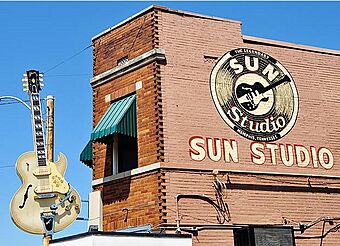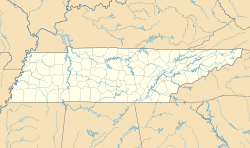Sun Studio facts for kids
|
Sun Record Company, Memphis Recording Service
|
|

Sun Studio in 2013
|
|
| Location | 706 Union Avenue, Memphis, Tennessee, U.S. |
|---|---|
| Area | less than one acre |
| Built | 1950 |
| NRHP reference No. | 03001031 |
Quick facts for kids Significant dates |
|
| Added to NRHP | July 31, 2003 |
| Designated NHL | July 31, 2003 |
Sun Studio is a famous recording studio located at 706 Union Avenue in Memphis, Tennessee. It was opened on January 3, 1950, by a music pioneer named Sam Phillips. The studio was first called Memphis Recording Service. It shared its building with the Sun Records label. This studio played a huge part in the early career of Elvis Presley.
Many people say that the first ever rock and roll song was recorded here. It was "Rocket 88" by Jackie Brenston and his Delta Cats in 1951. This led the studio to be known as the birthplace of rock and roll. Famous Blues and R&B artists also recorded here in the early 1950s. These included Howlin' Wolf, B.B. King, and Rufus Thomas.
Later in the 1950s, many rock and roll, country, and rockabilly artists recorded at Sun Studio. Some of these stars were Johnny Cash, Elvis Presley, Carl Perkins, Roy Orbison, and Jerry Lee Lewis. The studio became too small for all the artists. So, Sam Phillips opened a bigger studio in 1959 called Phillips Recording. In 1987, the original Sun Studio building was reopened. It became a recording studio and a popular place for tourists. Many famous artists like U2 and Ringo Starr have visited and recorded there.
Contents
How Sun Studio Started
In January 1950, Sam Phillips, who was a radio engineer, opened the Memphis Recording Service. He had help from his friend, Marion Keisker. Phillips had always dreamed of having his own recording studio. To earn money at first, Phillips recorded many different things. He recorded conventions, weddings, choirs, and even funerals. He also let anyone come in and record their own music for a small fee. Phillips' motto for his studio was "We Record Anything, Anywhere, Anytime."
In June 1950, Phillips and a friend, local DJ Dewey Phillips, started their own record label. It was called Phillips Records. They wanted to record Black artists from the South who had no other place to record. This first label did not do well. It closed after only one song was released.
"Rocket 88" and Early Success
After his first record label failed, Phillips worked with other labels. He made demo recordings for them. He also recorded master tapes for their artists. During this time, Phillips recorded "Rocket 88" by Jackie Brenston and his Delta Cats. Many people believe this was the first rock and roll song. Some say Phillips' creative ideas made the song sound special. Others think it was because the amplifier used was broken, which gave the music a "fuzzy" sound. The Sun Studio tour guides often say the amplifier was stuffed with newspaper.
Sun Records Label
In early 1952, Phillips started a new record label. He called it Sun Records. In its first year, he recorded several artists who became very successful. These included B.B. King, Joe Hill Louis, Rufus Thomas, and Howlin' Wolf. Even with these artists, Phillips found it hard to make enough money. He traveled many miles to promote his artists to radio stations. To save money, he paid his artists less than what was common at the time.
Rufus Thomas' song "Bearcat" was the first big hit for Sun in 1953. This song helped the label, but it also led to a legal problem about song rights. This problem almost caused Phillips' record label to go out of business. But Phillips kept his business going by recording other acts. One group was the Prisonaires, a Black quartet. They were allowed to leave prison in June 1953 to record their song, "Just Walkin' in the Rain." This song later became a hit for Johnnie Ray. The local newspaper wrote about this unique recording. Some people say this newspaper article made Elvis Presley want to record at Sun.
Elvis Presley's Start
In August 1953, Elvis Presley was 18 years old. He walked into Sun Studio. He wanted to pay for a few minutes of studio time. He recorded two songs: "My Happiness" and "That's When Your Heartaches Begin". He later said he wanted the record for his mother. Or maybe he just wanted to hear what he sounded like. But there was a cheaper place to make records nearby. So, some think he hoped to be discovered.
The receptionist, Marion Keisker, asked Elvis what kind of singer he was. He said, "I sing all kinds." When she asked who he sounded like, he kept saying, "I don't sound like nobody." After he recorded, Phillips asked Keisker to write down Elvis's name. She also wrote, "Good ballad singer. Hold." Elvis recorded two more songs in January 1954. But still, nothing big happened.
Phillips was always looking for a white singer who sounded like Black musicians. He believed such a singer could become very famous. In June, Phillips heard a song called "Without You." He thought it might be good for Elvis. Elvis came to the studio but couldn't sing the song well. Even so, Phillips asked Elvis to sing all the songs he knew. Phillips was impressed. He invited two local musicians, guitarist Scotty Moore and bass player Bill Black, to play with Elvis.
Their recording session was on the evening of July 5. It was not going well until late at night. As they were about to leave, Elvis started playing a blues song from 1946, "That's All Right" by Arthur Crudup. He was jumping around and having fun. Bill Black and Scotty Moore joined in. Sam Phillips heard them from the control room. He quickly started recording. This was the special sound he had been searching for!
Three days later, popular Memphis DJ Dewey Phillips played "That's All Right" on his radio show. Listeners called in, wanting to know who the singer was. The interest was so high that the DJ played the song many times. He even interviewed Elvis on the radio. He asked Elvis what high school he went to. This was to let listeners know Elvis was white, as many thought he was Black. Soon after, the trio recorded a bluegrass song, "Blue Moon of Kentucky" by Bill Monroe. They gave it a unique style. Phillips added a special echo effect he called "slapback." A record was made with "That's All Right" on one side and "Blue Moon of Kentucky" on the other.
Selling Elvis Presley's Contract
Within months, Sun Records grew a lot because of Elvis's records. Radio stations and stores across the South wanted to play them. As Elvis became more famous, Phillips realized Sun was not big enough. It couldn't make Elvis a national star. In February 1955, Phillips met with Colonel Tom Parker. Parker was known for his skills in managing artists. Parker convinced Phillips that Elvis needed a bigger record label.
After several months, Phillips agreed to sell Elvis's contract. He asked for a $5,000 payment by November 15. This was an advance on a total of $35,000. At that time, $35,000 was a huge amount of money for a singer's contract. Especially for one who was not yet famous across the whole country.
Elvis did not want to leave Sun. But Phillips sold his contract because he needed money. He had debts and costs from the "Bearcat" song rights issue. Phillips later said he asked for $35,000 because he thought it would stop other labels from buying the contract. But Elvis signed with RCA Victor in November 1955 and left Sun. Phillips used some of the money to help his other artists. These included Johnny Cash, Carl Perkins, Jerry Lee Lewis, and Roy Orbison.
Million Dollar Quartet
On December 4, 1956, something special happened at Sun Studio. Elvis Presley, Jerry Lee Lewis, Carl Perkins, and Johnny Cash had an unplanned music session. This jam session seemed to happen by chance. Carl Perkins was at the studio to record new songs. He was already famous for "Blue Suede Shoes". Phillips had brought in Jerry Lee Lewis to play piano on Perkins' session. Lewis was not yet famous outside Memphis.
Later that afternoon, Elvis Presley visited the studio with his girlfriend. Elvis was the biggest star in music at that time. He had topped the music charts many times. He had also appeared on The Ed Sullivan Show to a huge audience.
After talking with Phillips, Elvis listened to Perkins' recording. He liked it. Then he went into the studio, and the jam session began. At some point, Sun artist Johnny Cash also came in. Cash had recently had some hit songs. The engineer that day, Jack Clement, decided to record the session. He thought it was too important to miss. After playing many songs for an hour, Elvis and his girlfriend left. Jerry Lee Lewis kept playing the piano.
Phillips saw this as a great chance for publicity. He called a local newspaper. A reporter and a photographer came to the studio. The next day, an article about the session was in the newspaper. It was titled "Million Dollar Quartet". The article included a famous photo. It showed Elvis at the piano, with Lewis, Perkins, and Cash around him. This photo proves Cash was there. However, the audio recording does not clearly show he joined in the singing.
Sun Studio Today
For several years after Elvis left, Phillips had success with other artists. Sun Studio became known as a place that helped new talent grow. In 1959, Phillips moved Sun Studio to a bigger building. By the mid-1960s, Phillips became more interested in radio. He opened several radio stations. Sun Studio lost its fame as a top recording studio. In 1968, Sun released its last record. In 1969, Shelby Singleton bought the Sun label from Phillips. Singleton moved the company to Nashville, Tennessee. He sold the original Sun Studio building. It was used by a plumbing company, then an auto parts store. The original recording studio became a storage room.
Since then, the old Sun Records Studio has been used in movies. These include Walk the Line, Great Balls of Fire, and Mystery Train.
Re-opening and Modern Use
In 1987, the Sun Studio at 706 Union Avenue was opened again as a recording studio. It quickly became a popular place for tourists. Many famous musicians have recorded there. These include U2, Def Leppard, and John Mellencamp. In 2003, it was officially named a National Historic Landmark. This means it is a very important historical place.
In May 2009, Canadian blues artist JW-Jones recorded there. He worked with blues legend Hubert Sumlin. In July 2009, John Mellencamp recorded nine songs for his album No Better Than This at the studio. In 2011, Chris Isaak released "Beyond the Sun." This album had songs recorded at Sun Studio. Most were cover versions of songs first released on Sun Records.
Sun Studio often shares studio session podcasts online. They also have a TV series called Sun Studio Sessions. This series started in January 2010.
See also
 In Spanish: Estudio Sun para niños
In Spanish: Estudio Sun para niños



